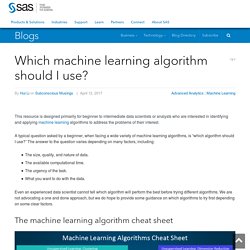

Turning any CNN image classifier into an object detector with Keras, TensorFlow, and OpenCV. Home - Acumos. A Complete Machine Learning Walk-Through in Python: Part Two. Every value that is NaN represents a missing observation.

While there are a number of ways to fill in missing data, we will use a relatively simple method, median imputation. This replaces all the missing values in a column with the median value of the column. In the following code, we create a Scikit-Learn Imputer object with the strategy set to median. We then train this object on the training data (using imputer.fit) and use it to fill in the missing values in both the training and testing data (using imputer.transform). (We have to do imputation this way rather than training on all the data to avoid the problem of test data leakage, where information from the testing dataset spills over into the training data.) All of the features now have real, finite values with no missing examples. Feature Scaling Scaling refers to the general process of changing the range of a feature.
We will scale the features by putting each one in a range between 0 and 1. Random Search with Cross Validation. AWS Training and Certification : cours sur le Machine Learning (ML) Top 10 Machine Learning Algorithms For Beginners. By Rekhit Pachanekar Alan Turing, an English mathematician, computer scientist, logician, and cryptanalyst, surmised about machines that, “It would be like a pupil who had learnt much from his master but had added much more by his own work.

When this happens I feel that one is obliged to regard the machine as showing intelligence.” To give you an example of the impact of machine learning, Man group’s AHL Dimension programme is a $5.1 billion dollar hedge fund which is partially managed by AI. After it started off, by the year 2015, its machine learning algorithms were contributing more than half of the profits of the fund even though the assets under its management were far less. After reading this blog, you would be able to understand the basic logic behind some popular and incredibly resourceful machine learning algorithms which have been used by the trading community as well as serve as the foundation stone on which you step on to create the best machine learning algorithm.
Conclusion. Top 8 open source AI technologies in machine learning. Artificial intelligence (AI) technologies are quickly transforming almost every sphere of our lives. From how we communicate to the means we use for transportation, we seem to be getting increasingly addicted to them. Because of these rapid advancements, massive amounts of talent and resources are dedicated to accelerating the growth of the technologies. Here is a list of 8 best open source AI technologies you can use to take your machine learning projects to the next level. 1. TensorFlow Initially released in 2015, TensorFlow is an open source machine learning framework that is easy to use and deploy across a variety of platforms. Created by Google for supporting its research and production objectives, TensorFlow is now widely used by several companies, including Dropbox, eBay, Intel, Twitter, and Uber. TensorFlow is available in Python, C++, Haskell, Java, Go, Rust, and most recently, JavaScript. 2.
Keras is known for its user-friendliness, modularity, and ease of extensibility. 3. 4. 5. What is the best Python library for Hidden Markov Models? Which machine learning algorithm should I use? - Subconscious Musings. This resource is designed primarily for beginner to intermediate data scientists or analysts who are interested in identifying and applying machine learning algorithms to address the problems of their interest.

A typical question asked by a beginner, when facing a wide variety of machine learning algorithms, is “which algorithm should I use?” The answer to the question varies depending on many factors, including: The size, quality, and nature of data.The available computational time.The urgency of the task.What you want to do with the data. Even an experienced data scientist cannot tell which algorithm will perform the best before trying different algorithms. We are not advocating a one and done approach, but we do hope to provide some guidance on which algorithms to try first depending on some clear factors. The machine learning algorithm cheat sheet Additional algorithms will be added in later as our library grows to encompass a more complete set of available methods.